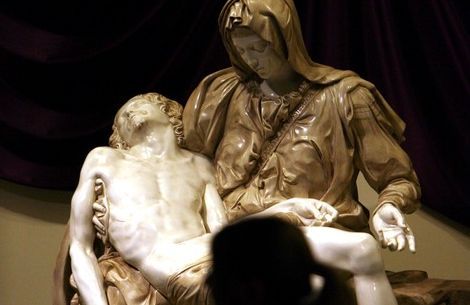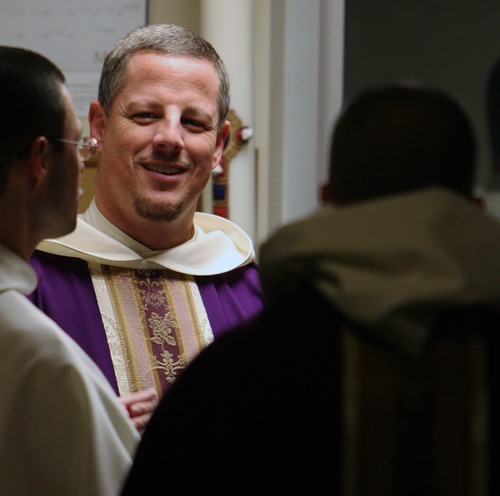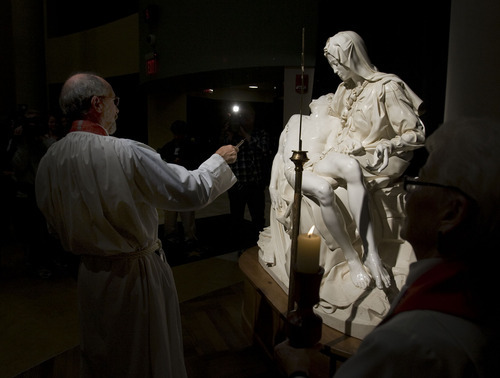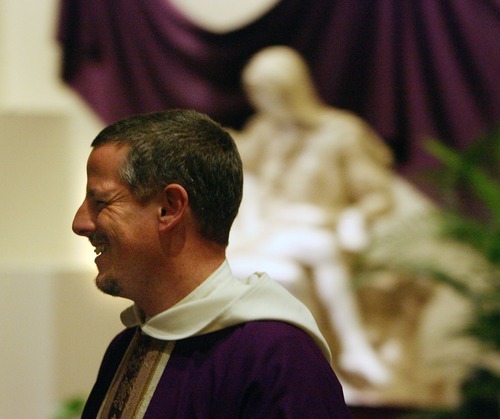This is an archived article that was published on sltrib.com in 2011, and information in the article may be outdated. It is provided only for personal research purposes and may not be reprinted.
Sheila and Melissa Anderson, mother and daughter, gaze on Pieta, the Renaissance sculpture of mother and son, and are struck by where it leads them.
"Your eyes are drawn to her, not to him," Sheila says. "You feel her pain."
"You feel what a mother would feel, losing a child," says Melissa, a parishioner at the St. Catherine of Siena Newman Center at the University of Utah, where a cast replica of Pieta is on display through the end of May. "It is just a very powerful image of motherhood."
Indeed, the power of Michelangelo's masterpiece of Mary holding Jesus Christ's crucified body in her lap, an icon of the Christian faith for more than five centuries, is bound up in its focus on Mary, says Diane Apostolos-Cappadona.
"What is more disastrous, what is more unnatural than for a mother to see a child die in her lifetime?" asks Apostolos-Cappadona, a Georgetown University adjunct professor of religious art and cultural history.
For the Rev. Carl Schlichte, pastor of St. Catherine, the statue provides a perfect point of reflection for his parishioners in this season when Christians remember Christ's passion and crucifixion before celebrating his resurrection at Easter.
"She is," Schlichte says, "God's gift to us for Lent."
Michelangelo was not yet 25 when he carved Pieta from a block of white marble he chose at a Carrara, Italy, quarry in 1498. He had been commissioned by a French cardinal to sculpt a piece that would go on his grave.
Apostolos-Cappadona says the young artist drew on a motif from the north, in what later would be Germany, where images of the Madonna with her slain son arose in the 1300s as part of the liturgical tradition on Good Friday, the day Christians recall the crucifixion.
The image — called "vesperbild" — had made its way into French art but was not yet popular in Italy, which is perhaps why the French cardinal wanted Michelangelo to use the image.
"He's challenging Michelangelo," Apostolos-Cappadona says, "to make something that no one can ever do better."
Pieta's motif did not arise from scripture — no such scene exists in the Bible — but from the devotional practices of the faithful, she notes. The word "pieta" stems from the Greek word for pity or compassion.
Michelangelo was a devout Catholic, but also influenced by platonic philosophy, which would have considered wrinkles and gray hair as signs of one's long sexual life.
That Pieta's Madonna — indeed, most images of Mary — is a young woman rather than a middle-aged mother holding her grown son conveys the Catholic belief that she was ever virgin.
In Michelangelo's Pieta, Mary is larger than her son and would in fact tower over him if she were standing.
"With Michelangelo, anatomy is always theology," Apostolos-Cappadona says. "When he makes a body out of proportion, it's always for a reason."
In Pieta's case, one message the sculptor wanted to convey is that Jesus is Mary's baby, though a grown man.
Mary's eyes are not on his face or his wounds, but on his diaphragm.
"She is looking like the mother who is going in to see if the child is sleeping," Apostolos-Cappadona says. "It's the genius of Michelangelo. People have tried to mimic that and it doesn't work."
Mary's face is serene, even heroic, as was typical in art of the Middle Ages, which emphasized her willingness to accept God's call to carry his son, even though he would die.
In a sense, Michelangelo sculpted an outsized Mary as an image of the church, Apostolos-Cappadona says. "The arms of mother church encompass all of us."
As an art student in the early 1970s, Apostolos-Cappadona was able to walk around and touch Pieta as she made sketches in St. Peter's Basilica in Rome, where Michelangelo's statue has been for centuries.
But, in 1972, a mentally ill man took a geologist's hammer to the statue. Mary's fingers and face were damaged; her nose had to be refashioned from a block of marble out of the back of the statue.
After that attack, the Vatican put the statue behind an clear acrylic shield, so visitors no longer are able to get close or touch Pieta.
The replica on display at St. Catherine is essentially the same size as the original at St. Peter's Basilica, says Steven Bishop, owner of Vescovo Buonarroti Art, the company that secured rights to make castings of the original statue from the Vatican Observatory Foundation.
His company also owns a different replica that was on display at St. Mark's Hospital in Millcreek Township late last year.
Vescovo Buonarroti Art, based in Nevada but moving to Arizona, has six replicas touring the United States and Mexico, all cast at a foundry in Utah that Bishop declines to name.
One of the pieces, going for $250,000, was bought by the Cathedral of St. Paul in Minnesota after it was shown there during Lent last year.
The castings are a mix of marble and resin, based on a prototype made from molds of the original Pieta in the 1930s, he says. That provenance — giving these replicas a genealogy to the original — is where the value lies in the Vescovo Buonarroti replicas, Bishop says.
The replicas weigh 750 pounds apiece and sit on 400-pound pedestals.
Schlichte considers it God's providence that brought the statue to his parish, which lacked the $2,000 needed to cover shipping and the cost of hosting a reception to educate about the statue. Bishop loaned the statue even without a guarantee of payment.
On the first weekend the statue was in the church's lobby, parishioners put up $700 to offset costs. Schlichte figures the rest of the money will be donated.
Schlichte blessed and unveiled the statue March 25, the Feast of the Annunciation, when Catholics celebrate Mary's acceptance of Angel Gabriel's message that God wanted her to bear his son.
"As one parishioner said, it [the statue] looks like she's handing Jesus back to the Father," Schlichte says. "It's a wonderful catechetical tool. I've heard any number of parents using it to teach their children."
The replica at St. Catherine is not the only one in Utah.
Juan Diego Catholic High School in Draper has a Pieta as part of its Our Lady of Sorrows Plaza on the southeast side of the campus, at the edge of the track.
Christ United Methodist Church in Salt Lake City has a life-size replica made of marble from the same quarry in Carrara, Italy, that Michelangelo used.
The replica, sculpted by a famous 20th-century artist, Palla, was created in Pietrasanta, Italy.
The 6,400-pound sculpture was donated to the church in 1993 by a Utah family to honor their deceased grandchildren, says Beverly Mittelstadt, a member of the church.
Early on, it upset some Methodists to see the sorrowful statue of Christ and his mother, says Mittelstadt, who provides guided tours of the statue on request.
"Some members were a little upset over it because it isn't something you usually see in a Methodist church," she adds. "But it's just a fabulous piece of art."
Through the years, Mittelstadt says, art history students from area high schools as well as other groups have studied the piece. They gain an appreciation of Michelangelo.
"In that day, when a lot of people did not read and didn't have a Bible," Mittelstadt says, "it [the statue] was to represent the sacrifice of Christ, so it does move you in that way."
For Aaron Miller, a St. Catherine parishioner, even the replica is "breathtaking."
"Mom and Dad went to Rome and saw the original," he says. "Now I don't have to go to Rome to see it for myself."
The art of faith — a yearlong series
P Throughout 2011, The Salt Lake Tribune is featuring a monthly series about religious art. Today: Michelangelo's Pieta.
To read previous stories in the series, go to http://www.sltrib.com. —
Where to see Pieta replicas
P Three large replicas can be found in the Salt Lake Valley. The host churches and school welcome visitors to view the statues, free of charge.
St. Catherine of Siena Newman Center • 170 S. University St., Salt Lake City, has a cast marble replica on loan until May 31. The Pieta is in the gathering place outside the sanctuary and can be seen during business hours or at worship times on weekends and Wednesday nights.
Mass is at 5 p.m. Saturday; 8:30 a.m., 10:45 a.m. and 7 p.m. Sundays; 12:10 p.m. weekdays and 9 p.m. Wednesday nights. More information: http://www.unewman.org
Christ United Methodist Church • 2375 E. 3300 South, has a permanent marble Pieta, sculpted by an Italian artist and donated to the church in 1993. The church welcomes visitors from 9 a.m. to 4 p.m. weekdays, and before and after worship on Sundays.
Services are at 8 a.m., 9 a.m. and 10:30 a.m. More information: http://littleurl.info/methodistpieta
Juan Diego Catholic High School • 300 E. 11800 South, Draper, has a Pieta in the southeastern part of campus on its Our Lady of Sorrows Plaza. The replica is about two-thirds the size of the original.
Lit during the late afternoon and evening in winter, it is accessible via the walkway between the school's football stadium and baseball field, at the far side of the track. School's website: http://www.jdchs.org —
'Michelangelo made this'
The Pieta, sculpted by a young Michelangelo in 1498-1499, is the only piece bearing the signature of the famed artist. The sculpture went on display in the old St. Peter's Basilica even before it was complete, and the 24-year-old artist overheard speculation that an older artist was responsible.
Michelangelo's biographer, a student and colleague, wrote that the annoyed artist chiseled into the diagonal sash across Mary's breast "Michelangelo Buonarroti, Florentine, made this."
Michelangelo, the biographer wrote, forever regretted his outburst of pride and did not put his name on future works, including his famous "David" sculpture and the frescoes of the Sistine Chapel. —
Pieta's road trip and scar
The Pieta has left the Vatican only once: to travel to New York for the World's Fair in 1964-65. A replica was made beforehand and took the original's place in St. Peter's Basilica during its absence.
It wasn't long after the original's return to the basilica that a mentally ill man took a hammer to Pieta, shattering the left arm of Mary and damaging her nose, left eye and veil. Tourists made off with some of the pieces during the 1972 attack, but many later were returned and used in the repairs.
Now, visitors to St. Peter's Basilica can see Pieta only through a clear acrylic barrier.
Replicas throughout the world often allow people to touch the statue, as generations touched Michelangelo's original.









